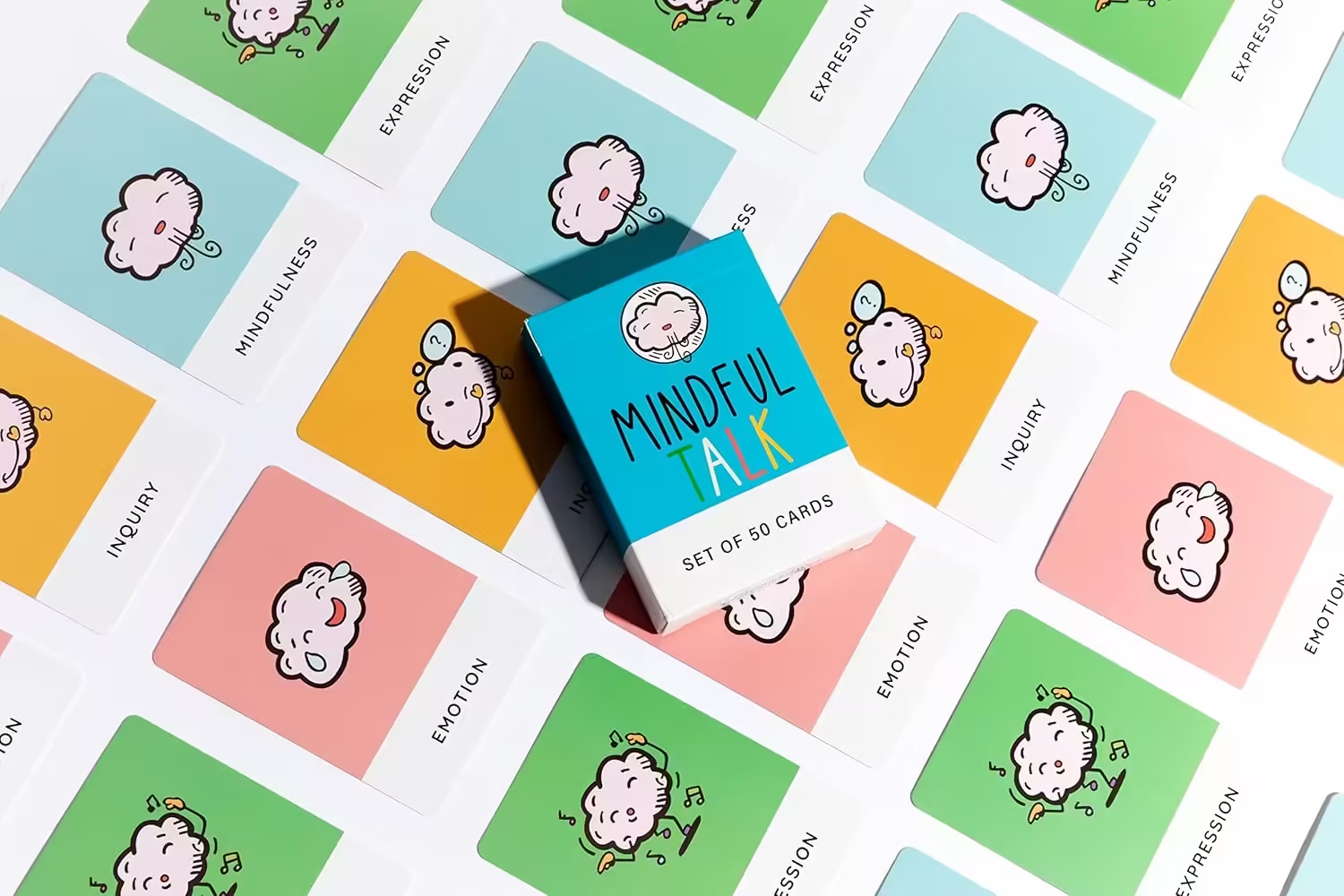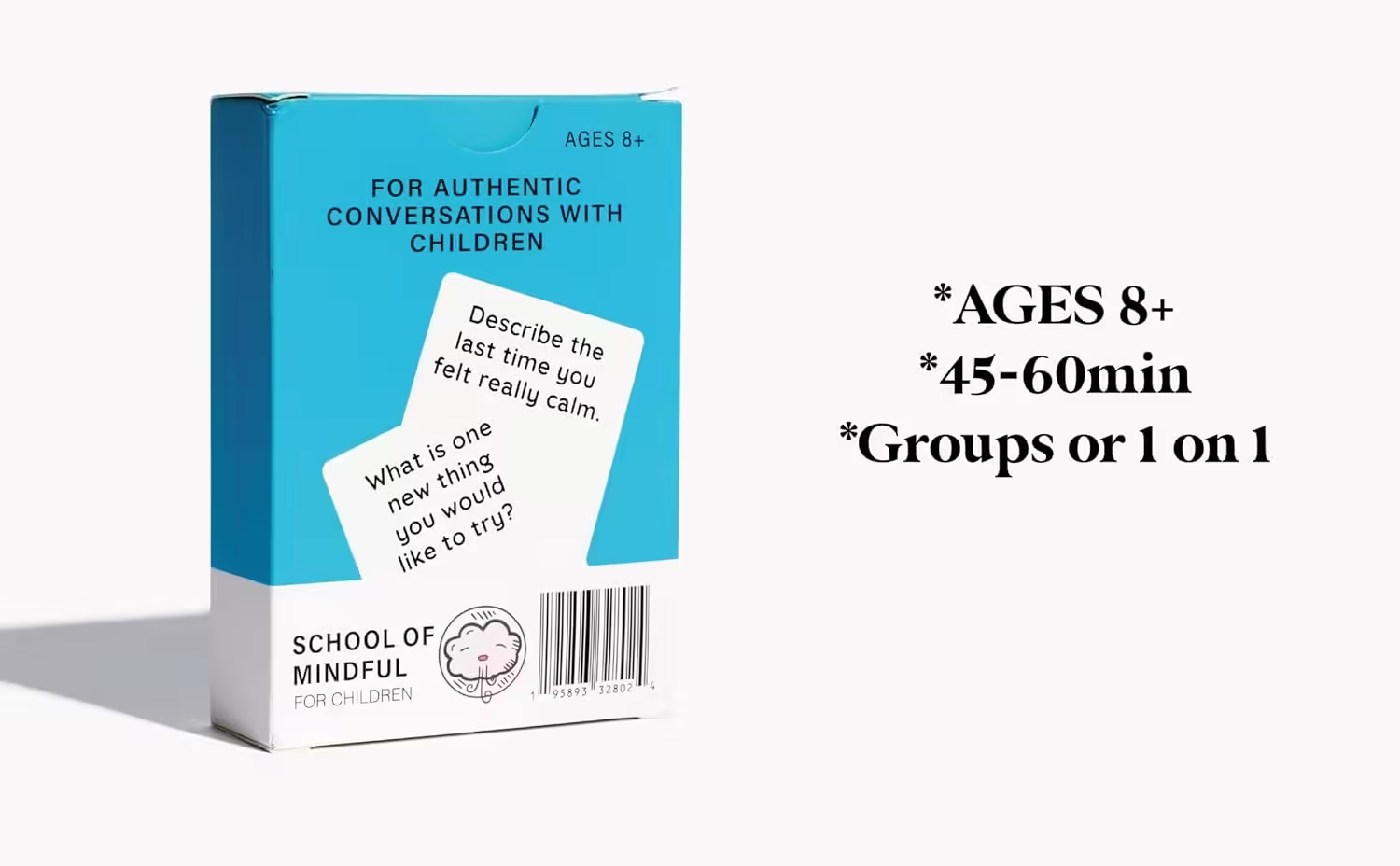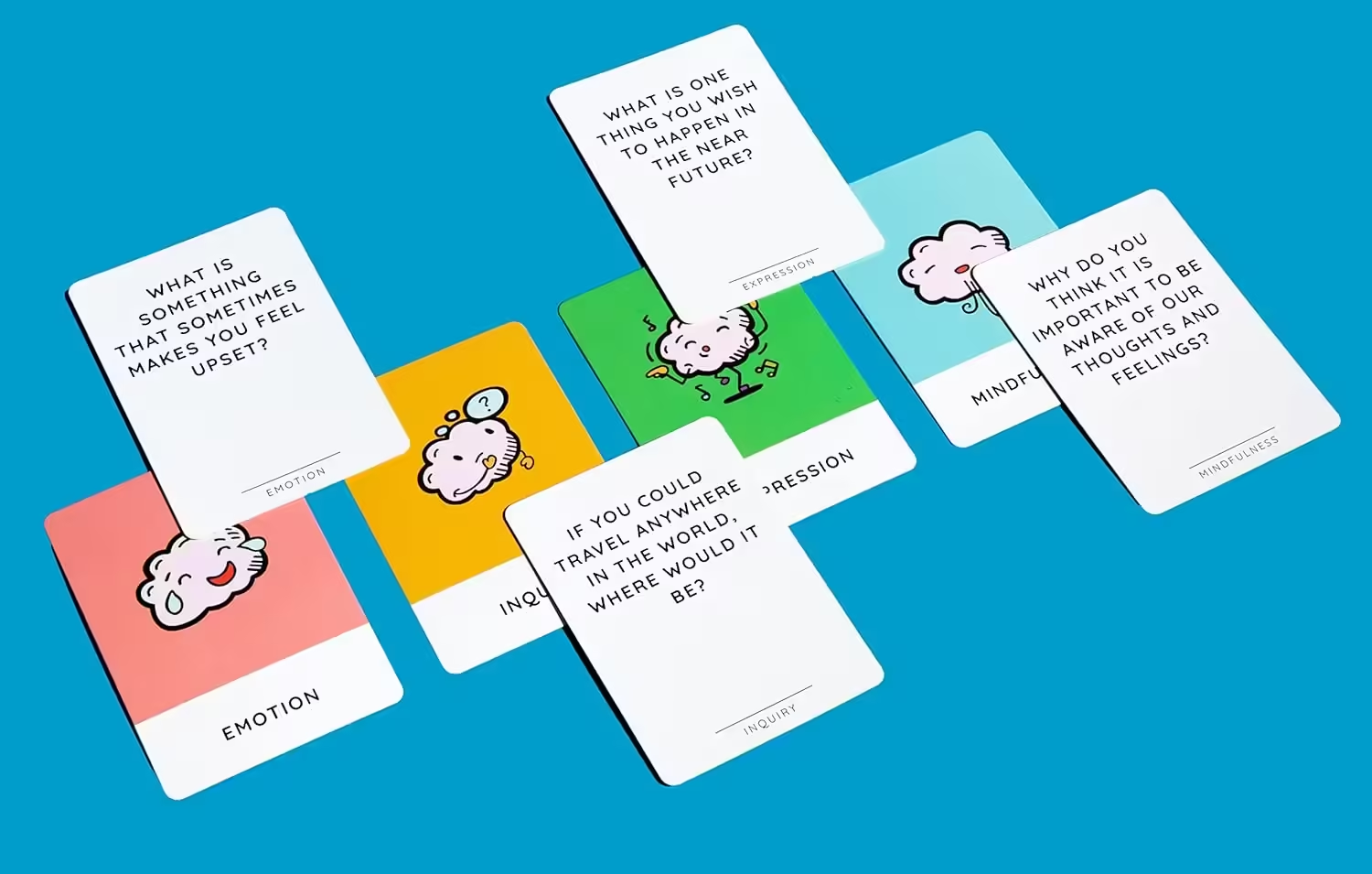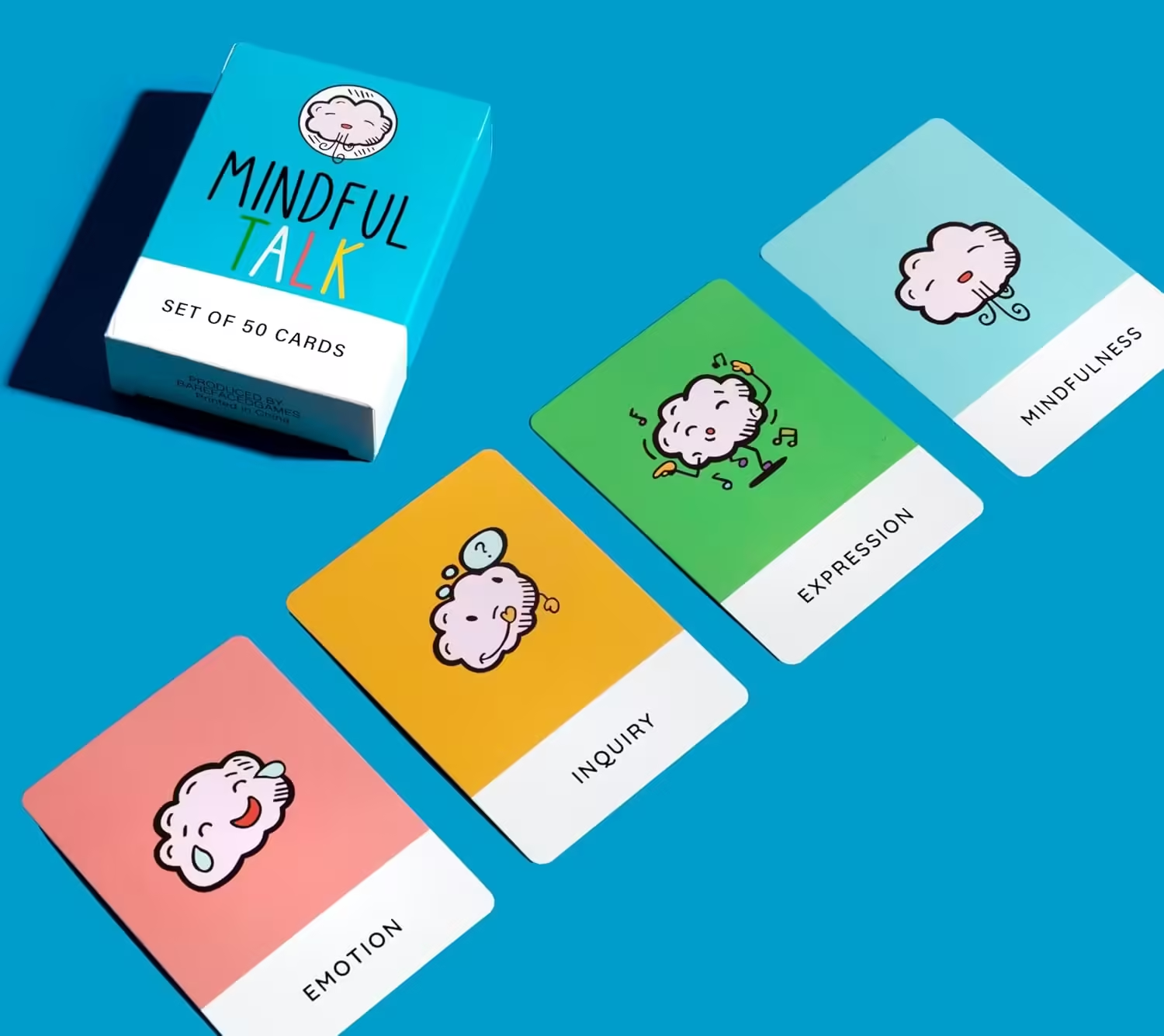Mindfulness activities are becoming increasingly popular as a way to help children build emotional intelligence, improve focus, and manage stress. Teaching mindfulness to kids doesn’t have to be complicated—there are fun and engaging ways to incorporate mindfulness into their daily routines. One of the most effective tools is the Mindfulness Game for Kids, a card-based game that provides 50 different prompts designed to encourage self-reflection, emotional expression, and meaningful conversations. In this guide, we’ll explore the benefits of mindfulness for kids and how you can use these activities to help your child thrive.



What are Mindfulness Activities for Kids?
Mindfulness activities are exercises that help children become more aware of their thoughts, feelings, and surroundings. These activities often involve simple breathing techniques, guided meditations, or sensory awareness exercises. The Mindfulness Game for Kids adds an element of fun and creativity, using game cards that guide children through various mindfulness exercises, such as focusing on their emotions, breathing, and physical sensations. The game is designed for kids aged 8 and up and can be played one-on-one or in a group setting, making it versatile for families, classrooms, or therapy sessions.
Improved Focus and Concentration
Mindfulness activities are proven to improve attention span by teaching kids how to focus on the present moment. Through breathing exercises and sensory awareness, children learn to clear their minds of distractions and focus on their immediate surroundings. The Mindfulness Game for Kids includes exercises that help children practice mindfulness in a way that’s both fun and engaging, which can translate to better focus in school and during homework. Studies show that mindfulness can help improve attention and cognitive performance in children Southcentral Foundation.
2. Emotional Regulation and Resilience
One of the most powerful benefits of mindfulness is its ability to help children regulate their emotions. By learning to recognize and understand their feelings, kids can better manage stress, anger, and frustration. The Emotion cards in the Mindfulness Game provide prompts for children to reflect on how they are feeling, helping them practice emotional regulation in a safe and structured way. Over time, this practice builds emotional resilience, preparing children to handle challenges more effectively Southcentral Foundation.
3. Open and Meaningful Conversations
Many mindfulness activities focus on self-reflection, but they can also be a great way to foster open communication between children and adults. The Inquiry and Expression cards in the game encourage children to explore thought-provoking questions, promoting deeper conversations about their thoughts and emotions. This helps kids develop better communication skills, empathy, and emotional intelligence Southcentral Foundation.
4. Reduced Anxiety and Stress
Mindfulness activities have been shown to reduce anxiety and stress by helping children focus on their breath and calm their nervous system. Techniques such as deep breathing and progressive muscle relaxation are easy for kids to learn and can be practiced anytime they feel overwhelmed. The Mindfulness Game for Kids makes it easy to integrate these relaxation techniques into daily routines through fun, engaging prompts that children will enjoy Southcentral Foundation.
5. Self-Reflection and Personal Growth
Mindfulness helps children develop greater self-awareness by encouraging them to reflect on their thoughts, actions, and feelings. The game’s Mindfulness and Emotion cards prompt kids to think about what they are feeling and why, promoting personal growth and emotional intelligence. As children continue to practice mindfulness, they become more in tune with themselves and better equipped to handle their emotions Southcentral Foundation.




How to Incorporate Mindfulness Activities with the Mindfulness Game for Kids
Mindfulness activities don’t have to be difficult or time-consuming. The Mindfulness Game for Kids offers a fun, structured way to incorporate mindfulness into your child’s routine. Here are some ways you can use the game to introduce mindfulness:
- Versatile Gameplay: The game includes 50 question cards divided into four categories: Mindfulness, Emotion, Inquiry, and Expression. Each category focuses on different aspects of mindfulness, allowing kids to explore their thoughts, emotions, and surroundings in a playful way.
- Group or Solo Play: The game can be played with 2-6 players, making it perfect for family game nights or classroom activities. The group setting allows children to learn from each other while practicing mindfulness.
- Scannable Resources: The game also includes scannable resources that provide additional instructions and tips for practicing mindfulness. These resources make it easy for parents and teachers to guide children through the exercises, even if they are new to mindfulness practices Southcentral Foundation.
About Mindfulness Activities for Kids
-
What are some simple mindfulness activities for kids?
Simple activities like deep breathing, body scans, and mindful coloring are effective mindfulness exercises for children. The Mindfulness Game for Kids includes fun prompts that make these exercises even more engaging.
-
How does mindfulness help kids manage stress?
Mindfulness teaches children to focus on their breath and calm their minds, reducing feelings of anxiety and stress.
-
At what age should kids start practicing mindfulness?
Mindfulness can be introduced to children as young as 4-5 years old, but the Mindfulness Game for Kids is designed for kids aged 8 and up.
-
How can I make mindfulness fun for kids?
Using interactive games like the Mindfulness Game for Kids adds an element of play, which makes mindfulness more enjoyable for children.
-
Can mindfulness activities improve behavior in school?
Yes, mindfulness improves focus, emotional regulation, and behavior, leading to better performance in school.
-
What are the best mindfulness activities for reducing anxiety in children?
Breathing exercises, progressive muscle relaxation, and body scans are great mindfulness activities for reducing anxiety in kids.
-
How long should a mindfulness session for kids last?
A typical mindfulness session for kids can last between 5-10 minutes. The Mindfulness Game for Kids offers sessions that last around 45-60 minutes.
-
Can mindfulness help kids with ADHD?
Yes, mindfulness has been shown to help children with ADHD improve focus, attention, and impulse control Southcentral Foundation.
-
What are mindfulness games for kids?
Mindfulness games, like the Mindfulness Game for Kids, incorporate fun exercises that teach kids how to stay present and manage their emotions.
-
How can I teach mindfulness to my child at home?
Teaching mindfulness at home can start with simple breathing exercises or by using a structured tool like the Mindfulness Game for Kids.
-
Can mindfulness activities help children sleep better?
Yes, mindfulness practices such as deep breathing and body scans can help children relax and fall asleep more easily.
-
What mindfulness techniques can improve focus in kids?
Techniques like mindful breathing, sensory awareness, and progressive muscle relaxation can all help improve focus in children.
-
What are fun mindfulness activities for groups of kids?
Activities like mindful movement or games such as the Mindfulness Game for Kids work well for groups and encourage collaboration.
-
What are the benefits of mindfulness activities for children?
Mindfulness activities help improve focus, emotional regulation, self-awareness, and reduce anxiety in children.
-
Can mindfulness activities help children with emotional regulation?
Yes, mindfulness teaches children to observe their emotions without judgment, which helps them regulate their feelings more effectively.
-
How do mindfulness activities improve social skills in kids?
Mindfulness improves empathy and communication, which helps children develop stronger social skills Southcentral Foundation.
-
Can mindfulness be practiced outdoors with kids?
Absolutely! Mindfulness walks or outdoor sensory activities are great ways to practice mindfulness with children in nature.
-
How often should kids practice mindfulness?
A few minutes of mindfulness every day is ideal for building the habit. The Mindfulness Game for Kids can be played weekly for more in-depth practice.
-
What materials are needed for mindfulness activities?
Most mindfulness activities only require a quiet space. Tools like the Mindfulness Game for Kids provide structured prompts for deeper engagement.
-
How can teachers incorporate mindfulness into the classroom?
Teachers can start with simple breathing exercises or use structured games like the Mindfulness Game for Kids to integrate mindfulness into classroom routines.
Mindfulness activities are a powerful way to help children develop emotional intelligence, focus, and resilience. The Mindfulness Game for Kids offers a hands-on approach to teaching these skills, making mindfulness both fun and accessible. By incorporating these activities into your child’s routine, you can help them build lifelong habits that will support their mental and emotional well-being.
Explore more tools for smarter living in our Game On On category on Designs24hr.







